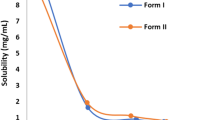Abstract
Dissolution profile comparisons are used by the pharmaceutical industry to assess the similarity in the dissolution characteristics of two formulations to decide whether the implemented changes, usually minor/moderate in nature, will have an impact on the in vitro/in vivo performance of the drug product. When similarity testing is applied to support the approval of lower strengths of the same formulation, the traditional approach for dissolution profile comparison is not always applicable for drug products exhibiting strength-dependent dissolution and may lead to incorrect conclusions about product performance. The objective of this article is to describe reasonable biopharmaceutic approaches for developing a biowaiver strategy for low solubility, proportionally similar/non-proportionally similar in composition immediate release drug products that exhibit strength-dependent dissolution profiles. The paths highlighted in the article include (1) approaches to address biowaiver requests, such as the use of multi-unit dissolution testing to account for sink condition differences between the higher and lower strengths; (2) the use of a single- vs. strength-dependent dissolution method; and (3) the use of single- vs. strength-dependent dissolution acceptance criteria. These approaches are cost- and time-effective and can avoid unnecessary bioequivalence studies.






Similar content being viewed by others
References
Wang Q, Fotaki N, Mao Y. Biorelevant dissolution: methodology and application in drug development. Dissolut Technol. 2009;16(3):6–12.
Anand O, Lawrence XY, Conner DP, Davit BM. Dissolution testing for generic drugs: an FDA perspective. AAPS J. 2011;13(3):328–35.
Shah VP. Dissolution: a quality control test vs. a bioequivalence test. Dissolut Technol. 2001;8(4):6–7.
Duan JZ, Riviere K, Marroum P. In vivo bioequivalence and in vitro similarity factor (f 2) for dissolution profile comparisons of extended release formulations: how and when do they match? Pharm Res. 2011;28(5):1144–56.
U.S. Food and Drug Administration/Center for Drug Evaluation and Research. FDA guidance for industry: immediate release solid oral dosage forms: scale-up and postapproval changes: chemistry, manufacturing, and controls, in vitro dissolution testing, and in vivo bioequivalence documentation. November 1995. http://www.fda.gov/downloads/Drugs/Guidances/UCM070636.pdf (Accessed on 11 June 2015).
U.S. Food and Drug Administration/Center for Drug Evaluation and Research. Guidance for industry: SUPAC-MR: modified release solid oral dosage forms: scale-up and postapproval changes: chemistry, manufacturing, and control; In Vitro Dissolution Testing, and In Vivo Bioequivalence Documentation. September 1997. http://www.fda.gov/downloads/Drugs/GuidanceComplianceRegulatoryInformation/Guidances/UCM070640.pdf (Accessed on 03/31/2015).
Code of Federal Regulations (CFR), Title 21CFR320.22. http://www.accessdata.fda.gov/scripts/cdrh/cfdocs/cfcfr/CFRSearch.cfm?fr=320.22 (Accessed on 05/18/2015).
U.S. Food and Drug Administration/Center for Drug Evaluation and Research. FDA draft guidance for industry: bioavailability and bioequivalence studies submitted in NDAs or INDs—general considerations. March 2014. http://www.fda.gov/downloads/Drugs/GuidanceComplianceRegulatoryInformation/Guidances/UCM389370.pdf (Accessed on 03/23/2015).
Stevens RE, Gray V, Dorantes A, Gold L, Pham L. Scientific and regulatory standards for assessing product performance using the similarity factor, f2. AAPS J. 2015;17(2):301–6.
Kaur P, Jiang X, Duan J, Stier E. Applications of in vitro–in vivo correlations in generic drug development: case studies. AAPS J. 2015;1–5.
Kesisoglou F, Hermans A, Neu C, Yee KL, Palcza J, Miller J. Development of in vitro–in vivo correlation for amorphous solid dispersion immediate‐release suvorexant tablets and application to clinically relevant dissolution specifications and in‐process controls. J Pharm Sci. 2015.
U.S. Food and Drug Administration/Center for Drug Evaluation and Research. Guidance for industry: extended release oral dosage forms: development, evaluation, and application of in vitro/in vivo correlations. September 1997. http://www.fda.gov/downloads/Drugs/GuidanceComplianceRegulatoryInformation/Guidances/UCM070239.pdf (Accessed on 05/06/2015).
Dickinson PA, Lee WW, Stott PW, Townsend AI, Smart JP, Ghahramani P, et al. Clinical relevance of dissolution testing in quality by design. AAPS J. 2008;10(2):380–90.
Suarez SS, Marroum PJ, Hughes M. Biopharmaceutic considerations in drug product design and in vitro drug product performance. In: Shargel L, Yu ABC, editors. Applied biopharmaceutics and pharmacokinetics. Seventhth ed. New York: McGraw-Hill Education; 2016. p. 415–67.
Suarez S. Establishing clinically relevant drug product specifications: FDA perspective. AAPS Annual Meeting and Exposition. Chicago, IL, 2012. http://www.fda.gov/downloads/AboutFDA/CentersOffices/OfficeofMedicalProductsandTobacco/CDER/UCM341185.pdf (Accessed on 09/23/2015).
Baxter JL, Kukura J, Muzzio FJ. Hydrodynamics-induced variability in the USP apparatus II dissolution test. Int J Pharm. 2005;292(1):17–28.
Author information
Authors and Affiliations
Corresponding author
Ethics declarations
Conflict of Interest
There are no conflicts of interest to declare.
Disclaimer
This article reflects the views of the authors and should not be construed to represent FDA’s views or policies.
Rights and permissions
About this article
Cite this article
Suarez-Sharp, S., Delvadia, P.R., Dorantes, A. et al. Regulatory Perspectives on Strength-Dependent Dissolution Profiles and Biowaiver Approaches for Immediate Release (IR) Oral Tablets in New Drug Applications. AAPS J 18, 578–588 (2016). https://doi.org/10.1208/s12248-016-9893-2
Received:
Accepted:
Published:
Issue Date:
DOI: https://doi.org/10.1208/s12248-016-9893-2




